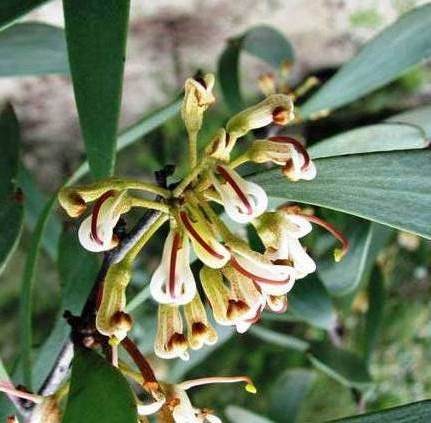Hakea pandanicarpa
(Hakea pandanicarpa)

Description
Hakea pandanicarpa is a shrub species in the family Proteaceae. It is endemic to south-west Western Australia. Hakea pandanicarpa is a non-lignotuberous open erect shrub or small tree 1–4.5 m (3–10 ft) high. White-cream to greenish flowers appear on racemes with 4-14 flowers along the length of the stalk. Branchlets and young leaves are closely pressed to the stem and covered in short soft hairs. Single leaves are narrowly elliptic or egg-shaped 3–12 cm (1–5 in) long and 0.3–1.6 cm (0.1–0.6 in) wide with a short stalk at its base tapering to rounded at the apex ending in a hard blunt point. Fruit are obliquely egg-shaped 4.5–5.5 cm (2–2 in) long and 3.7–4.5 cm (1–2 in) wide with small uneven corky pyramid shaped protuberances on the surface. The species was first formally described in 1830 by botanist Robert Brown who observed the species growing between Cape Arid and Lucky Bay. Brown's description was published in Supplementum primum prodromi florae Novae Hollandiae.The specific epithet is said to be derived from the genus Pandanus - screw pine and the Greek carpa - fruit. The proper word for fruit in ancient Greek is however karpos Two subspecies are currently recognised: H. pandanicarpa subsp. crassifolia (Meisn.) R.M.Barker. Subspecies crassifolia can be identified by the fruit mainly having a smooth surface at a young age, becoming rougher as it ages but still comparatively smooth. The external pattern on the fruit of subsp. crassifolia resembles that of "drying mud in a clay pan". This subspecies grows from Corrigin to Albany and east to Ravensthorpe. H. pandanicarpa R.Br. subsp. pandanicarpa Subspecies pandanicarpa has prominent raised corky pyramid-shaped projections on the fruit from a young age. Subspecies pandanicarpa has a more easterly distribution than subsp. crassifolia. It grows from the Fitzgerald River National Park east to Israelite Bay.
Taxonomic tree:







